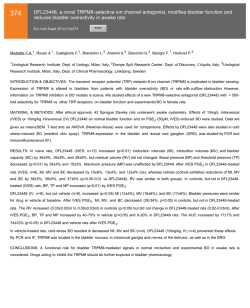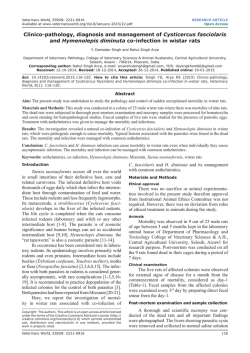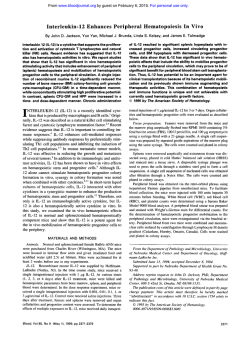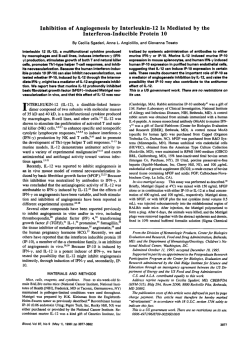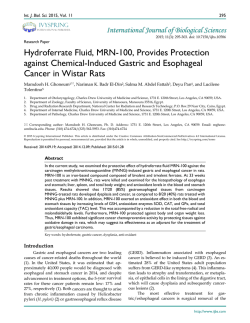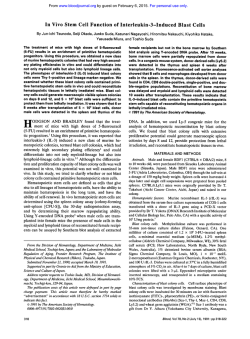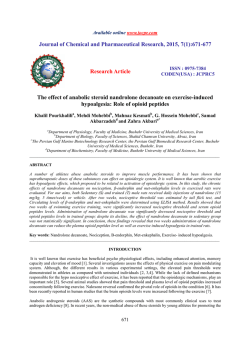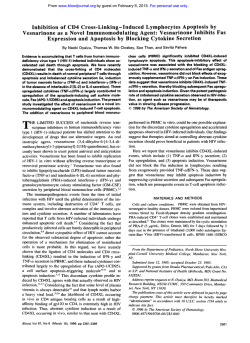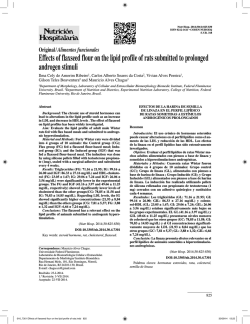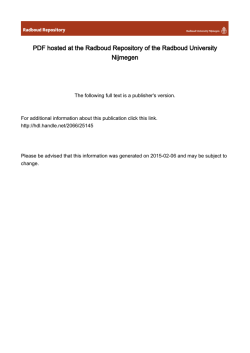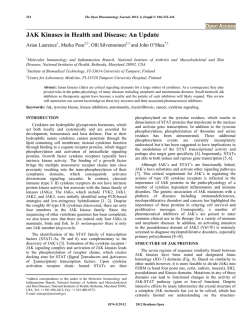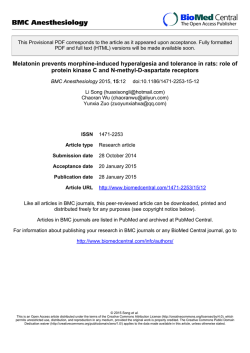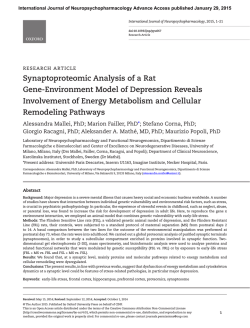
arquivo de notícias - UNESP: Câmpus de Botucatu
Toxicology and Applied Pharmacology 194 (2004) 132 – 140 www.elsevier.com/locate/ytaap Chemically induced immunotoxicity in a medium-term multiorgan bioassay for carcinogenesis with Wistar rats Ana Lu´cia Tozzi Spinardi-Barbisan, a Ramon Kaneno, b Luı´s Fernando Barbisan, c Joa˜o Lauro Viana de Camargo, a and Maria Aparecida Marchesan Rodrigues a,* b a Departamento de Patologia, TOXICAN, Faculdade de Medicina, UNESP, 18618-000 Botucatu, SP, Brazil Departamento de Microbiologia e Imunologia, Instituto de Biocieˆncias, UNESP, 18618-000 Botucatu, SP, Brazil c Departamento de Morfologia, Instituto de Biocieˆncias, UNESP, 18618-000 Botucatu, SP, Brazil Received 27 May 2003; accepted 19 September 2003 Abstract A variety of chemicals can adversely affect the immune system and influence tumor development. The modifying potential of chemical carcinogens on the lymphoid organs and cytokine production of rats submitted to a medium-term initiation-promotion bioassay for carcinogenesis was investigated. Male Wistar rats were sequentially initiated with N-nitrosodiethylamine (DEN), N-methyl-N-nitrosourea (MNU), N-butyl-N-(4hydroxybutyl)nitrosamine (BBN), dihydroxy-di-n-propylnitrosamine (DHPN), and 1,2-dimethylhydrazine (DMH) during 4 weeks. Two initiated groups received phenobarbital (PB) or 2-acetylaminofluorene (2-AAF) for 25 weeks and two noninitiated groups received only PB or 2-AAF. A nontreated group was used as control. Lymphohematopoietic organs, liver, kidneys, lung, intestines, and Zymbal’s gland were removed for histological analysis. Interleukin (IL)-2, IL-12, interferon gamma (IFN-g), tumor necrosis factor alpha (TNF-a), IL-10, and transforming growth factor beta1 (TGF-h1) levels were determined by ELISA in spleen cell culture supernatants. At the fourth week, exposure to the initiating carcinogens resulted in cell depletion of the thymus, spleen and bone marrow, and impairment of IL-2, IL-12, and IFN-g production. However, at the 30th week, no important alterations were observed both in lymphoid organs and cytokine production in the different groups. The results indicate that the initiating carcinogens used in the present protocol exert toxic effects on the lymphoid organs and affect the production of cytokines at the initiation step of carcinogenesis. This early and reversible depression of the immune surveillance may contribute to the survival of initiated cells facilitating the development of future neoplasia. D 2003 Elsevier Inc. All rights reserved. Keywords: Initiation-promotion model; Chemical carcinogens; Cytokines; Immunotoxicity; Lymphoid organs Introduction A variety of environmental chemical contaminants may trigger deleterious effects on the immune system increasing the susceptibility to infections, autoimmune diseases, and cancer development. Among them, chemical carcinogens like polychlorinated biphenyls, chlorinated dibenzo-pdioxins, pesticides, and heavy metals have shown immunotoxic activity (Descotes et al., 2000; De Wall et al., 1992; Kimber and Dearman, 2002; Luster and Rosenthal, 1993; Luster et al., 1990; Vandebriel et al., 1998a; Voccia et al., 1999). * Corresponding author. Fax: +55-14-3815-2348. E-mail address: [email protected] (M.A.M. Rodrigues). 0041-008X/$ - see front matter D 2003 Elsevier Inc. All rights reserved. doi:10.1016/j.taap.2003.09.012 Experimental studies have demonstrated that chemicals such as cyclosporin A, 2,3,7,8,-tetrachlorodibenzo-p-dioxin (TCDD), tributyltin oxide (TBTO), and azathioprine, among other substances, modulate both the cytokine-receptor mRNA expression and cytokine protein levels (Vandebriel et al., 1998a, 1998b). Besides, alterations of cytokine levels have been reported in several types of cancer (Merendino et al., 1999; Merogi et al., 1997; O’Hara et al., 1998). Since chemical carcinogens influence both the immune system and cancer development, the evaluation of cytokine production may be a valuable tool to investigate the participation of the immune system on tumor development (Cohen et al., 1999; Foster, 2001; Vandebriel et al., 1998b). Cytokines are important in promoting the proliferation and differentiation of hematopoietic cells and in regulating A.L.T. Spinardi-Barbisan et al. / Toxicology and Applied Pharmacology 194 (2004) 132–140 the nature of immune response. Interleukin-12 (IL-12) has the ability to skew the immune response in favor of Th1, that is, induce the differentiation of naive T-helper cells (Th0) to the Th1-profile inhibiting Th2 cell development. Because Th1 cells produce interferon gamma (IFN-g), IL2, IL-3, and tumor necrosis factor alpha and beta (TNF-a and TNF-h), they are more suited for the enhancement of cellular immunity, although Th2 cells (which produce IL-3, IL-4, IL-5, IL-6, IL-9, IL-10, IL-13, and TNF-a) are better qualified in helping B cells to differentiate into antibodyproducing cells (Mossman and Sad, 1996). Cytokines such as IL-2, IL-12, and IFN-g may activate natural killer (NK) cells and cytotoxic T cells enhancing the host immune response against malignant cells (Ikeda et al., 2002; Oppenheim and Fujiwara, 1996; Trinchieri, 1995). Tumor necrosis factor (TNF-a) is a major mediator of inflammation with action directed towards both tissue destruction and recovery from damage (Balkwill, 2002). Besides, TNF-a may act as an endogenous tumor promoter, contributing to the tissue remodeling and stromal development necessary for tumor growth and spread (Balkwill, 2002; Schreiber and Rowley, 1999; Seung et al., 1999). Other cytokines, such as transforming growth factor beta (TGFh) and IL-10, may act as immune suppressive factors and promote the growth of some tumors (O’Hara et al., 1998; Seung et al., 1999). A medium-term multiorgan system, based on the initiation-promotion concept of chemical carcinogenesis, has been proposed as an alternative and complementary approach to the conventional long-term bioassay for detection of chemical carcinogens (Ito et al., 1992, 1998; Takahashi et al., 1992). It consists of a multiorgan initiation of carcinogenesis with five genotoxic carcinogens followed by the exposure of the animals to a test substance to evaluate its promoting potential (Ito et al., 1992, 1998; 133 Takahashi et al., 1992). A task group gathered at the International Agency for Research on Cancer (IARC) in 1999 recognized that this bioassay could be considered appropriate for identifying carcinogens in rodents (IARC, 1999). This alternative model allows to investigate the immune alterations that can occur at the initiation step of the carcinogenic process, after DNA damage induced by the initiating chemicals, or at the promotion step, when proliferation of altered cell clones had given rise to preneoplastic and neoplastic lesions (Spinardi et al., 1999; SpinardiBarbisan et al., 2000). The aim of the present study was to investigate the influence of the chemical carcinogens used in a mediumterm multiorgan bioassay in male Wistar rats on lymphoid organs and cytokine production at different stages of chemical carcinogenesis. Material and methods Animals. Male Wistar rats, 4-week-old, were purchased from CEMIB—Centro Multidisciplinar de Investigacßa˜o Biolo´gica (UNICAMP, Campinas, SP, Brazil) and housed in polypropylene cages (four per cage) in a environmentcontrolled room maintained at 22 F 2 jC, 55 F 10% relative humidity and a 12:12 h light/dark cycle. Animals were supplied with filtered water and fed NUVILAB-CR1 (NUVITAL, Curitiba, PR, Brazil) ad libitum. After a 4-week acclimation period, animals weighing 225– 250 g were used in this study. Chemical agents. N-nitrosodiethylamine (DEN), N-methylN-nitrosourea (MNU), 1,2-dimethylhydrazine (DMH), and 2-acetylaminofluorene (2-AAF) were purchased from Sigma Chemical Co. (St. Louis, MO, USA); N-butyl-N- Fig. 1. Experimental design (for details, see Materials and methods). 134 A.L.T. Spinardi-Barbisan et al. / Toxicology and Applied Pharmacology 194 (2004) 132–140 Table 1 Body weight gain and organ relative weights (mean F SD) of animals submitted to a medium-term multiorgan carcinogenesis model (4th and 30th weeks) Groups Number of animals Body weight gain (g) 4th week Control DMBDDb 20 20 30th week Control PBc 2-AAFd DMBDD DMBDD/PB DMBDD/2-AAF 15 19 20 20 20 17 Relative weight (%) Liver Kidneya Spleen Thymus 106.60 F 11.29 3.10 F 28.99* 4.05 F 0.25 3.47 F 0.43* 0.31 F 0.02 0.38 F 0.06* 0.38 F 0.03 0.57 F 0.11* 0.16 F 0.02 0.09 F 0.03* 234.93 245.63 166.60 176.40 193.05 137.35 3.15 3.74 5.10 3.11 3.79 6.29 0.24 0.25 0.28 0.28 0.28 0.33 0.31 0.30 0.41 0.38 0.40 0.44 0.04 0.07 0.05 0.05 0.05 0.06 F F F F F F 52.38 43.83 26.43* 35.29* 46.29*,*** 45.96* F F F F F F 0.33 0.35 0.62* 0.23 0.41** 0.90*,** F F F F F F 0.02 0.03 0.03* 0.05* 0.03*,*** 0.04*,**,**** F F F F F F 0.06 0.06 0.06* 0.07 0.15*** 0.10* F F F F F F 0.01 0.06 0.01 0.02 0.01 0.06 a Mean values of right and left kidneys. Group initiated with the DEN, BBN, MNU, DHPN, and DMH. c Phenobarbital. d 2-acetylaminofluorene. * Significantly different from control group; P < 0.0001 for all comparisons. ** Significantly different from DMBDD group; P < 0.0001 for all comparisons. *** Significantly different from PB group; P < 0.0001 for all comparisons. **** Significantly different from 2-AAF group; P < 0.0001 for all comparisons. b (4hydroxybutyl)nitrosamine (BBN) and phenobarbital (PB) were purchased from Tokyo Kasei Industries Co. (Tokyo, Japan) and dihydroxy-di-n-propylnitrosamine (DHPN) from Nakalai Tesque, Inc. (Kyoto, Japan). Experimental design. The experimental protocol is shown in Fig. 1. Animals were allocated to six groups (n = 15 – 20 rats each) as follows. A an untreated group was used as control, maintained on basal diet and sacrificed at the weeks 4 and 30. Three other groups (DMBDD, DMBDD/PB, and DMBDD/2-AAF) were sequentially treated with five chemical initiators: DEN (100 mg/kg body wt, ip, single dose at the commencement), MNU (20 mg/kg body wt, ip, four times, two doses per week), and BBN (0.05% in drinking water during 2 weeks) administered during weeks 1 and 2; DHPN (0.1% in drinking water during 2 weeks) and DMH (40 mg/kg body wt, sc, four times, two doses per week) administered during weeks 3 and 4. Some animals of the DMBDD group were killed at the end of the week 4 and the remaining were maintained on basal diet until the week 30. After the initiation, the DMBDD/PB and DMBDD/2-AAF groups were supplied with PB (0.05%) or 2-AAF (0.01%) in the diet for 25 weeks, respectively. Two noninitiated groups (PB and 2-AAF) received PB or 2-AAF in the diet, from the 6th until the 30th week. Body weight, water and food consumption were registered weekly during the first 4 weeks (initiation step) and then at every 15 days until the end of the experiment. All animals were killed under pentobarbital (45 mg/kg body wt) anesthesia at the 4th or 30th week. The protocols used were in accordance the Ethical Principles for Animal Research adopted by the Brazilian College of Animal Experimentation (COBEA) and were approved by the local Ethical Committee for Animal Research (protocol no. 116). Tissue processing and histological analysis. Liver, kidneys, spleen, thymus, mesenteric lymph nodes, and bone marrow from all animals were fixed in buffered formalin for 48 h. The lung, small and large intestine, and Zymbal’s gland were examined only at the week 30. Liver, kidneys, spleen, and thymus were weighed immediately after removal. The spleen was cut in two halves, one for evaluation of cytokines and other for histological analysis. All organs removed were embedded in paraffin and stained with hematoxylin and eosin (H&E) for histological analysis. Histological diagnosis was performed according to Monographs on Pathology of Tumors in Laboratory Animals (IARC, 1990) and Kuper et al. (2000). Table 2 Histological changes in lymphohematopoietic organs at the fourth week Organ changesa Control group DMBDD groupb Bone marrow Decreased global cellularity Thymus Decreased cortex/medulla ratio Decreased cortex cellularity Spleen Decreased PALS cellularityd Decreased marginal zone cellularity Increased red pulp cellularity Extramedullar hematopoiesis Mesenteric lymph nodes Increased paracortex cellularity Erythrocyte rosette formation Histiocytosis (20)c 0 (20) 0 0 (20) 0 0 0 0 (20) 0 0 0 (20) 20 (100%) (20) 5 (25%) 20 (100%) (20) 12 (60%) 12 (60%) 4 (20%) 5 (25%) (18) 7 (39%) 4 (22%) 12 (67%) a Semiquantitative diagnostic terms according to Kuper et al. (2000). Group initiated with the carcinogens DEN, BBN, MNU, DHPN, and DMH. c Number of analyzed organs. d Periarteriolar lymphocyte sheath. b A.L.T. Spinardi-Barbisan et al. / Toxicology and Applied Pharmacology 194 (2004) 132–140 135 Fig. 2. Lymphohematopoietic organs of male Wistar rats stained with H&E at the fourth week. Thymus: (a) normal; c, cortex and m, medulla (25); (b) thinning of the thymic cortex (25); and (c) increased number of macrophages ingesting apoptotic cells in the cortex (starry sky appearance) in a DMBDDtreated rat (90); spleen: (d) normal; f, follicule; mz, marginal zone; pals, periarteriolar lymphocyte sheath; rp, red pulp (30); (e) diminished cellularity and reduction of white pulp in a DMBDD-treated rat (30); bone marrow: (f) normal (90); (g) cell depletion in a DMBDD-treated rat (90); lymph nodes: (h) erythrocyte rosette (90) and (i) histiocytosis after DMBDD treatment (120). 136 A.L.T. Spinardi-Barbisan et al. / Toxicology and Applied Pharmacology 194 (2004) 132–140 Spleen cells culture. Spleen cells were mechanically dispersed in a Petri dish containing RPMI-1640 culture medium (Cultilab, Campinas, SP, Brazil). The cell suspensions were centrifuged, resuspended in RPMI-1640 culture medium supplemented with 20 mg/ml gentamycin (Sigma Co.), 2 mM glutamine (GibcoBRL, Gaithersburg, MD, USA) and 10% inactivated fetal calf serum (Cultilab, Campinas, SP, Brazil), and washed twice at 1500 rpm, for 10 min. Cell viability, assessed by Trypan blue exclusion, was always greater than 90%. Aliquots of 2 106 cells/ml (500 Al/well) were incubated with RPMI1640 (500 Al/well) or stimulated in vitro with Concanavalin A (CON A—2.5 Ag/ml, 500 Al/well) (Sigma Co.) or Staphylococcus aureus Cowan’s strain 1 (SAC—1:5000, 500 Al/well) (Calbiochem, San Diego, CA, USA) in 24well flat-bottom microtiter plates for 72 h in a humidified atmosphere of 5% CO2, at 37 jC. Following incubation, supernatants were collected and stocked at 70 jC for quantification of cytokines. Samples stimulated in vitro with CON A were used to quantify IL-2, IFN-g, IL-10, and TGF-h1, and samples stimulated in vitro with SAC were used to quantify TNF-a and IL-12. Analysis of cytokine levels. Cytokine production was determined by enzyme-linked immunosorbent assay (ELISA) using commercial kits according to the manufacturer’s instructions. IL-2, IL-12, TNF-a, IFN-g, and IL-10 levels were measured using ELISA kits from BioSource International (Nivelles, Belgium). For detection of the TGF-h1 immunoreactive form, samples were acidified by addition of 1 N HCl and then measured by Quantikine anti-human TGF-h1 kit (R&D Systems, Minneapolis, USA). The plates were read at 450 nm using an ELISA microplate reader set (Multiskan Ex, Labsystems, Finland). Cytokine quantities in the samples were calculated from standard curves of recombinant cytokines using a regression linear method. 1). At the fourth week, the relative liver and thymus weights were significantly decreased ( P < 0.0001) when compared with the control group. In contrast, the relative kidneys and spleen weights were significantly increased ( P < 0.0001) (Table 1). At the 30th week, the relative liver and spleen weights were significantly increased ( P < 0.001) after treatment with 2-AAF (DMBDD/2-AAF and 2-AAF groups vs. control group) and the DMBDD/PB group presented higher ( P < 0.0001) mean spleen relative weight than the PB group (Table 1). At this point, the kidney relative weights were significantly higher ( P < 0.0001) in all treated groups, except in the PB group (Table 1). Histological analysis The main histological changes on lymphoid organs and in bone marrow were observed after the initiation step of carcinogenesis at the end of the fourth week (Table 2). At this moment, the exposure to the chemical initiators resulted in significant thinning of the thymic cortex due to increased apoptosis of lymphocytes, easily visible by the increased number of macrophages ingesting apoptotic cells (Figs. 2a– c). As a consequence, the cortex/medulla ratio was decreased and the connective tissue of the thymus became prominent. In the spleen, there was cell depletion of the white pulp, specially of the periarteriolar lymphocyte sheath (PALS) and of the marginal zone (Figs. 2d and e). The bone marrow showed severe hypoplasia (Figs. 2f and g) and the mesenteric lymph nodes presented erythrocyte rosettes formation (Fig. 2h), histiocytosis (Fig. 2i), and increased Table 3 Incidence of animals with neoplastic lesions and total number of tumors (30th week) Groups Statistical analysis. Body weight gain, organ relative weights, and production of cytokines were analyzed by the Student’s t test or Mann – Whitney test at week 4 (initiation step) and by analysis of variance (ANOVA) or Kruskal – Wallis test at week 30 (promotion step). The incidence of benign or malignant neoplasias and number of neoplasias per group (tumor burden) were analyzed by the Fisher’s exact test or the Chi square and Kruskal – Wallis tests, respectively, at the 30th week. Differences between groups were assumed to be significant when P < 0.05. Results Noninitiated Control 0 (15)a b 0 (19) PB 2-AAFc 0 (20) Initiated DMBDDd 14 (20) DMBDD/ 18 (20) PB DMBDD/ 17 (17) 2-AAF a The body weight gain was significantly reduced ( P < 0.0001) after the treatment with the carcinogens both at the initiation and promotion step, except in the PB group (Table Benign neoplasia No. of animals 0 0 0 Malignant neoplasia No. of No. of tumors animals 0 0 0 0 0 0 Benign and malignant No. of tumors neoplasias 0 0 0 0 0 0 21 32 40 60 10 (50%) 19 15 (75%) 28 11 (55%) 12 (60%) 14 (82%) 32 16 (94%)y,* 49y,* 81y,** Effective number of animals. Phenobarbital. c 2-acetylaminofluorene. d Group initiated with the carcinogens DEN, BBN, MNU, DHPN, and DMH. y Significantly different from DMBDD group. * P < 0.01. ** P < 0.002. b Body and organ weights No. of animals with neoplasia A.L.T. Spinardi-Barbisan et al. / Toxicology and Applied Pharmacology 194 (2004) 132–140 cellularity at the paracortex area when compared to the control group. The animals submitted to the DMBDD treatment also presented liver alterations such as bile duct hyperplasia, Kupffer cells with hemossiderin pigment, centrilobular hepatocytic necrosis, extramedullary hematopoiesis, cariomegaly, vacuolization of hepatocytes, cytoplasmic basophilia, hepatocytic hypertrophy, mitotic figures and apoptotic cells. In the kidneys, there was focal or diffuse tubular hyperplasia in most animals of the DMBDD group (data not shown). At the 30th week, no significant alterations of the lymphoid organs were observed in the different groups. 137 Neoplastic lesions were found mainly in the initiated and promoted groups (DMBDD/PB and DMBDD/2-AAF groups) (Table 3). They were observed in the liver as adenoma, cholangioma and cholangiocarcinoma, in the colon as adenocarcinoma, in the kidney as mesenchymal renal tumor, in the lung as adenoma, and in the Zymbal’s gland as carcinoma. The treatment with 2-AAF after initiation (DMBDD/2-AAF group) induced significantly higher incidence of animals with malignant neoplasia ( P < 0.01), number of malignant tumors ( P < 0.01), and total number of tumors (benign + malignant) ( P < 0.002) than in the DMBDD group (Table 3). Cytokine production At the end of the fourth week, the production of IL-2, IL12, and IFN-g, but not of TNF-a, TGF-h1, and IL-10 by spleen cells cultured with CON A or SAC were significantly lower ( P < 0.01) in the DMBDD group than in the control group (Fig. 3). At the end of the 30th week, IFN-g production was significantly higher ( P < 0.001) in the groups treated with 2-AAF (DMBDD/2-AAF and 2-AAF groups vs. DMBDD group) but was not different from the control group (data not shown). IL-2, IL-12, TNF-a, IL-10, and TGF-h1 levels were not altered in the carcinogentreated groups at the 30th week (data not shown). Discussion Fig. 3. Production of IL-2, IL-12, and IFN-g by spleen cells of male Wistar rats in vitro stimulated with CON A or SAC after DMBDD treatment at the fourth week. *,**Significant differences among the groups at P < 0.001 and P < 0.01, respectively. Values are mean F SD. The present results indicate that chemicals used for initiation of carcinogenesis in an alternative multiorgan model affect the lymphoid organs of Wistar rats, causing cellular depletion in the bone marrow, in the thymic cortex, and in the white pulp of the spleen, at the end of the fourth week. Cytokine levels were also altered at the initiation step after the treatment with the five genotoxic carcinogens. Besides, the liver and the kidneys of the initiated animals presented important histological changes. The alterations observed in the thymus may result from the toxicity of the initiating carcinogens. Similar effects were noted in the thymus after treatment with organotin compounds and 2,3,7,8-tetrachlorodibenzo-p-dioxin (TCDD) (Kamath et al., 1997; Penninks et al., 1991). Toxic substances can cross blood –thymus barrier and directly affect the lymphocytes or indirectly act on epithelial reticule cells that support the thymocytes growth and maturation (De Wall et al., 1992). Others investigators have reported thymic changes very similar to those registered in the present study in rats exposed to MNU (Koestner et al., 1977; Talcott et al., 1990; Zwiiling et al., 1978). In fact, it is known that MNU has the lymphohematopoietic system as a target of its toxicity (Franchi et al., 2003; Zwiiling et al., 1978) and may act acutely on the proliferating cortical thymocytes leading them to apoptosis. Furthermore, the dramatic changes observed in the thymus could be a consequence 138 A.L.T. Spinardi-Barbisan et al. / Toxicology and Applied Pharmacology 194 (2004) 132–140 of the stress induced by the cocktail of chemical initiators as expressed by the marked decrease in body weight gain and food consumption. It is well known that the nutritional status and stress can result in thymus atrophy (Schuurman et al., 1994). In this context, we could argue that the effects on the thymus were in part due to direct effects of the chemicals, but the stress also have played an important role. This implies that the histological changes observed in the thymus in the present study should not be automatically considered as a first insult, but the end result of both the systemic stress and toxic effects of the chemicals. At the end of the fourth week, the bone marrow of initiated animals was also severely affected by exposure to the genotoxic carcinogens as characterized by depletion of myeloid, erythroid, and lymphoid cell lineages. In this manner, the alterations in the spleen white pulp and extramedullary hematopoiesis observed in the liver and spleen could be a consequence of cellular depletion observed in the bone marrow and in the thymus. However, hypercellularity at the paracortex area and histiocytosis of mesenteric lymph nodes could be due to antigenic stimulation induced by possible lesions on digestive tract and peritoneal cavity by the oral and intraperitoneal administrations of chemicals during the initiation treatment. The histological changes observed in the liver and kidneys immediately after initiation may be consequence of the toxicity of the chemical initiators that are metabolized in the liver, originating hepatotoxic and nephrotoxic metabolites (Kedderis, 1996; Schnellmann, 2001). Similar results in the liver and kidney were previously reported by our laboratory in Wistar rats treated by DHPN or DEN (Barbisan et al., 2002; Moreira et al., 2000). At the 30th week, after the promotion step of carcinogenesis, the absence of significant alterations on the lymphoid organs indicates that the immunotoxic changes induced by the initiating chemicals were restored. Similar recovery was described after glucocorticosteroid and organotin compound treatments, in which the tissue architecture was restored within 3 –4 weeks (Schuurman and Kuper, 1995). The absence of neoplasia in lymphoid organs agree with Franchi et al. (2003), who demonstrated that after 20 weeks, male Wistar rats exposed to MNU at 80, 160, and 240 mg/kg body wt, ip, only develop few vascular lesions in the hematopoietic system at intermediate and high doses, and thymic lymphomas at the highest dose. In contrast to initiated groups, no neoplasias were observed in the noninitiated groups at the end of the 30th week. These results show the amplitude of the initiating treatment used in this protocol, favoring DNA damage fixation in different target organs (IARC, 1999). Indeed, our results indicate that both the treatment with PB, a nongenotoxic carcinogen that acts promoting the development of liver preneoplastic lesions after previous exposure to DEN (Kitano et al., 1998; Maekawa et al., 1992) or with 2-AAF, a genotoxic carcinogen used in the protocols of hepatocarcinogenesis as a selective stimulator of initiated cells in the liver (Tiwawech et al., 1991), exerted an enhancing influence on the carcinogenic process. In the initiated groups and treated with PB or with 2-AAF, the liver was a main target organ, developing adenomas (35%) and cholangiomas (41%) or cholangiocarcinomas (35%), respectively (data not shown). In contrast, animals exposed only to PB or to 2-AAF did not present neoplasia, although developed rare or many putative preneoplastic liver foci, respectively (data not shown). These results documented the wellknown specific action of these chemicals on the liver (target organ) (Kitano et al., 1998; Maekawa et al., 1992, Tiwawech et al., 1991). The reduction of cytokine levels detected after initiation of carcinogenesis at the fourth week correlates well with the histological changes observed in the bone marrow and thymus. Exposure to the five chemical initiators decreased the levels of IL-2, IL-12 and IFN-g, but not of IL-10 and TGF-h1. The reduction of IL-12 production could also be related to the lowered IL-2 and IFN-g levels that are produced by Th1 cells. Indeed, IFN-g has a powerful enhancing effect on the ability of phagocytes and dendritic cells to produce IL-12, acting therefore as a potent positive feedback mechanism (Ikeda et al., 2002). In a previous study, we have demonstrated that the chemical initiators used in the present initiation-promotion protocol did not change the ratio CD4+/CD8+ cells as determined by flow cytometry and that the NK activity was not altered by chromium release assay (Spinardi et al., 1999; SpinardiBarbisan et al., 2000). In this context, the results of the present study suggest that the chemical initiators can affect the cytokine production not due to a change in the number or type of the spleen cells but as a result of reduced function of these cells. Besides, our results show differential sensitivity of the cells to the initiators, the Th1-pattern cytokines appearing to be more affected. These data suggest that the reduction of cytokine levels observed at the initiation step may reflect a selective toxicity of the chemical initiators on Th1 lymphocytes, which activate important mechanisms of the antitumor immune response, involving macrophages, dendritic cells, cytotoxic T lymphocytes, and NK cells (Pellegrini et al., 1996). Various studies have indicated the importance of cytokines in tumor immunology (Oppenheim and Fujiwara, 1996; Seung et al., 1999). O’Hara et al. (1998) demonstrated that patients with colorectal cancer have decreased IL-12 production and increased serum IL-10, and that these patients present increased tumor bulk and worse prognosis. Experimental models of transplantable tumors have shown that IL-12 drastically inhibits tumor growth and metastasis increasing the survival of the animals (Brunda et al., 1993). The ability of the IL-12 to prevent 3-methylcholantrene (MCA)-induced carcinogenesis, protecting for the growth of MCA-induced fibrosarcoma, has been clearly shown in BALB/c and IL-12 p40 knockout mice respectively treated with exogenous and endogenous IL-12 (Noguchi et al., 1996; Smyth et al., 2001). High IFN-g serum levels have been reported in mice after IL-12 systemic treatment con- A.L.T. Spinardi-Barbisan et al. / Toxicology and Applied Pharmacology 194 (2004) 132–140 tributing to tumor regression (Nastala et al., 1994). Considering that the Th1 cells are able to produce IL-2 and IFN-g, our data indicate that the deficient production of these cytokines induced by the genotoxic carcinogens treatments can inhibit the development of the cellular immune response, the most important mechanism of the antitumor immune response. The present results raise the possibility that the immunologic alterations expressed by the dramatic changes in the lymphoid organs and the decrease in cytokine production at the early stage of chemical carcinogenesis could favor the survival of initiated cells and facilitate the development of future neoplasia. Acknowledgments This research was supported by the Fundacßa˜o de Amparo a Pesquisa do Estado de Sa˜o Paulo (FAPESP 99/01524-4; 00/3736-8). References Balkwill, F., 2002. Tumor necrosis factor or tumor promoting factor? Cytokine Growth Factor Rev. 13, 135 – 141. Barbisan, L.F., Miyamoto, M., Scolastici, C., Salvadori, D.M.F., Ribeiro, L.R., Eira, A.F., de Camargo, J.L.V., 2002. Influence of aqueous extract of Agaricus blazei on rat liver toxicity induced by different doses of diethylnitrosamine. J. Ethnopharmacol. 83, 25 – 32. Brunda, M.J., Luistro, L., Warrier, R.R., Wright, R.B., Huddard, B.R., Murphy, M., Wolf, S.F., Gately, M.K., 1993. Antitumor and antimetastatic activity interleukin 12 against murine tumors. J. Exp. Med. 178, 1223 – 1230. Cohen, M.D., Schook, L.B., Oppenheim, J.J., Freed, B.M., Rodgers, K.E., 1999. Symposium overview: alteration in cytokine receptors by xenobiotics. Toxicol. Sci. 48, 163 – 169. Descotes, J., Choquet-Kastylevsky, G., Van Ganse, E., Vial, T., 2000. Responses of the immune system to injury. Toxicol. Pathol. 28, 479 – 481. De Wall, E.J., Schuurman, H.-J., Loeber, J.G., Van Loveren, H., Vos, J.G., 1992. Alterations in the cortical thymic epithelium of rats after in vivo exposure to 2,3,7,8-tetrachlorodibenzo-p-dioxin (TCDD): an (immuno)histological study. Toxicol. Appl. Pharmacol. 115, 80 – 88. Foster, J.R., 2001. The functions of cytokines and their uses in toxicology. Int. J. Exp. Pathol. 82, 171 – 192. Franchi, C.A.S., Bacchi, M.M., Padovani, C.R., de Camargo, J.L.V., 2003. Thymic lymphomas in Wistar rats exposed to N-methyl-N-nitrosourea (MNU). Cancer Sci. 94, 240 – 243. IARC, 1990. Tumors of the rat. In: Turusov, V.S., Mohr, U. (Eds.), Pathology of Tumours in Laboratory Animals. International Agency for Research on Cancer, Lyon, France, pp. 1 – 390. IARC, 1999. The use of short-term and medium-term tests for carcinogens and data on genetic effects in carcinogenic hazard evaluation. In: McGregor, D.B., Rice, J.M., Venitt, S. (Eds.), International Agency for Research on Cancer, Lyon, France, pp. 1 – 536. Ikeda, H., Old, L.J., Schreiber, R.D., 2002. The roles of IFN-g in protection against tumor development and cancer immunoediting. Cytokine Growth Factor Rev. 13, 95 – 109. Ito, N., Shirai, T., Hasegawa, R., 1992. Medium-term bioassays for carcinogens. In: Vainio, H., Magee, P.N., McGregor, D.B., McMichael, A.J. (Eds.), Mechanisms of Carcinogenesis in Risk Identification. International Agency for Research on Cancer, Lyon, France, pp. 356 – 388. 139 Ito, N., Imaida, K., Hirose, M., Shirai, T., 1998. Medium-term bioassays for carcinogenicity of chemical mixtures. Environ. Health Perspect. 106, 1331 – 1336. Kamath, A.B., Xu, H., Nagarkatti, P.S., Nagarkatti, M., 1997. Evidence for the induction of apoptosis in thymocytes by 2,3,7,8-tetrachlorodibenzop-dioxin in vivo. Toxicol. Appl. Pharmacol. 142, 367 – 377. Kedderis, G.L., 1996. Biochemical basis of hepatocellular injury. Toxicol. Pathol. 24, 77 – 83. Kimber, I., Dearman, R.J., 2002. Immune response: adverse versus nonadverse effects. Toxicol. Pathol. 30, 54 – 58. Kitano, M., Ichihara, T., Matsuda, T., Wanibuchi, H., Tamano, S., Hagiwara, A., Imaoka, S., Funae, Y., Shirai, T., Fukushima, S., 1998. Presence of a threshold for promoting effects of phenobarbital on diethylnitrosamineinduced hepatic foci in the rat. Carcinogenesis 19, 1475 – 1480. Koestner, A.W., Ruecker, F.A., Koestner, A., 1977. Morphology and pathogenesis of tumors of the thymus and stomach in Sprague – Dawley rats following intragastric administration of methyl nitrosourea (MNU). Int. J. Cancer 20, 418 – 426. Kuper, C.F., Harlerman, J.H., Richter-Reichelm, H.B., Vos, J.G., 2000. Histopathologic approaches to detect changes indicative of immunotoxicity. Toxicol. Pathol. 28, 454 – 466. Luster, M.I., Rosenthal, G.J., 1993. Chemical agents and the immune response. Environ. Health Perspect. 100, 219 – 236. Luster, M.I., Germolec, D.R., Rosenthal, G.J., 1990. Immunotoxicology: review of current status. Ann. Allergy 64, 427 – 432. Maekawa, A., Onodera, H., Ogasawara, H., Matsushima, Y., Mitsumori, K., Hayashi, Y., 1992. Threshold dose dependence in phenobarbital promotion of rat hepatocarcinogenesis initiated by diethylnitrosamine. Carcinogenesis 13, 501 – 503. Merendino, R.A., Gangemi, S., Misefari, A., Arena, A., Capozza, A.B., Chillemi, S., D’Ambrosio, F.P., 1999. Interleukin-12 and interleukin 10 production by mononuclear phagocytic cells from breast cancer patients. Immunol. Lett. 68, 355 – 358. Merogi, A.J., Marrogi, A.J., Ramesh, R., Robinson, W.R., Fermin, C.D., Freeman, S.M., 1997. Tumor-host interaction: analysis of cytokines, growth factors, and tumor-infiltrating lymphocytes in ovarian carcinomas. Hum. Pathol. 28, 321 – 331. Moreira, E.L.T., de Camargo, J.L.V., Rodrigues, M.A.M., Barbisan, L.F., Salvadori, D.M.F., 2000. Dose- and sex-related carcinogenesis by Nbis(2-hydroxypropyl)nitrosamine in Wistar rats. Jpn. J. Cancer Res. 91, 368 – 374. Mossman, T.R., Sad, S., 1996. The expanding universe of T-cell subsets: Th1, Th2 and more. Immunol. Today 17, 138 – 146. Nastala, C.L., Edington, H.D., McKinney, T.G., Tahara, H., Nalesnik, M.A., Brunda, M.J., Gately, M.K., Wolf, S.F., Schreiber, R.D., Storkus, W.J., Lotze, M.T., 1994. Recombinant IL-12 administration induces tumor regression in association with IFN-g production. J. Immunol. 153, 1697 – 1706. Noguchi, Y., Jungbluth, A., Richards, E.C., Old, L.J., 1996. Effect of interleukin 12 on tumor induction by 3-methylcholanthrene. Proc. Natl. Acad. Sci. U.S.A. 93, 1798 – 1801. O’Hara, R.J., Greenman, J., Macdonald, A.W., Gaskell, K.M., Topping, K.P., Duthie, G.S., Kerin, M.J., Lee, P.W.R., Monson, J.R.T., 1998. Advanced colorectal cancer is associated with impaired interleukin 12 and interleukin 10 production. Clin. Cancer Res. 4, 1943 – 1948. Oppenheim, J., Fujiwara, H., 1996. The role of cytokines in cancer. Cytokine Growth Factor Rev. 7, 279 – 288. Pellegrini, P., Berghella, A.M., Del Beato, Y., Cicia, S., Adorno, D., Casciani, C.C.U., 1996. Disregulation in Th1 and Th2 subsets of CD4+ T cells in peripheral blood of colorectal cancer patients and involvement in cancer establishment and progression. Cancer Immunol. Immunother. 42, 1 – 8. Penninks, A.H., Pieters, R.H.H., Snoeij, N.J., Seinem, W., 1991. Organotin-induced thymus atrophy. Thymus Update 4, 57 – 59. Schnellmann, R.G., 2001. Toxic responses of the kidney. In: Klaassen, C.D. (Ed.), Casarett and Doull’s Toxicology: The Basic Science of Poisons. McGraw-Hill, USA, pp. 491 – 514. 140 A.L.T. Spinardi-Barbisan et al. / Toxicology and Applied Pharmacology 194 (2004) 132–140 Schreiber, H., Rowley, D.A., 1999. Inflammation and cancer. In: Gallin, J.I., Syndeman, R. (Eds.), Inflammation: Basic Principles and Clinical Correlates. Lippincott Williams & Wilkins, Philadelphia, pp. 1117 – 1129. Schuurman, H.-J., Kuper, C.F., 1995. Pathology of the thymus: changes induced by xenobiotics and gene targeting. APMIS 103, 481 – 500. Schuurman, H.-J., Kuper, C.F., Vos, J.G., 1994. Histopathology of the immune system as a tool to assess immunotoxicity. Toxicology 86, 187 – 212. Seung, L.P., Rowley, D.A., Schreiber, H., 1999. Cytokines in cancer. In: Theze, J (Ed.), The Cytokine Network and Immune Functions. Oxford Univ. Press, Oxford, pp. 335 – 345. Smyth, M.J., Crowe, N.Y., Godfrey, D.I., 2001. NK cells and NKT cells collaborate in host protection from methylcholanthrene-induced fibrosarcoma. Int. Immunol. 13, 459 – 463. Spinardi, A.L.T., Kaneno, R., Rodrigues, M.A.M., Salvadori, D.M.F., Rocha, N., Barbisan, L.F., Ribeiro, L.R., de Camargo, J.L.V., 1999. Natural killer activity in a medium-term multi-organ bioassay for carcinogenesis. Jpn. J. Cancer Res. 90, 101 – 107. Spinardi-Barbisan, A.L.T., Kaneno, R., Rodrigues, M.A.M., Salvadori, D.M.F., Moreira, E.L.T., Barbisan, L.F., de Camargo, J.L.V., 2000. Lymphoproliferative response and T lymphocyte subsets in a medium-term multi-organ bioassay for carcinogenesis in Wistar rats. Cancer Lett. 154, 121 – 129. Takahashi, S., Hasegawa, R., Masui, T., Misoguchi, M., Fukushima, S., Ito, N., 1992. Establishment of multi-organ carcinogenesis bioassay using rats treated with a combination of five different carcinogens. J. Toxicol. Pathol. 5, 151 – 156. Talcott, P.A., Exon, J.H., Koller, L.D., 1990. The effects of methylnitrosourea (MNU) on natural killer (NK) cell cytotoxicity and cytokine production in rats. Carcinogenesis 11, 829 – 834. Tiwawech, D., Hasegawa, R., Kurata, Y., Tatematsu, M., Shibata, M.-A., Thamavit, W., Ito, N., 1991. Dose-dependent effects of 2-acetylaminofluorene on hepatic foci development and cell proliferation in rats. Carcinogenesis 12, 985 – 990. Trinchieri, G., 1995. Interleukin-12: a proinflamatory cytokine with immunoregulatory functions that bridge innate resistance and antigen-specific adaptive immunity. Annu. Rev. Immunol. 13, 251 – 276. Vandebriel, R.J., Meredith, C., Scott, M.P., Roholl, P.J.M., van Loveren, H., 1998a. Effects of in vivo exposure to bis(tri-n-butyltin)oxide, hexachlorobenzene, and benzo(a)pyrene on cytokine (receptor) mRNA levels in cultured rat splenocytes and on IL-2 receptor protein levels. Toxicol. Appl. Pharmacol. 148, 126 – 136. Vandebriel, R.J., Van Loveren, H., Meredith, C., 1998b. Altered cytokine (receptor) mRNA expression as a tool in immunotoxicology. Toxicology 130, 43 – 67. Voccia, I., Blakley, B., Brousseau, P., Fournier, M., 1999. Immunotoxicity of pesticides: a review. Toxicol. Ind. Health 15, 119 – 132. Zwiiling, B.S., Filppi, J.A., Chorpenning, F.W., Koestner, A., Rheins, M.S., 1978. Chemical carcinogenesis and immunity: immunologic status of rats treated with methylnitrosourea. J. Natl. Cancer Inst. 61, 731 – 735.
© Copyright 2026
